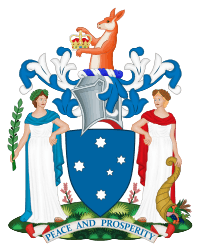Politics of Victoria
 |
| This article is part of a series on the politics and government of Australia |
|
|
|
Related topics |
Politics of the Australian state of Victoria takes place in the context of a constitutional monarchy with a bicameral parliamentary system, and like other Australian states, Victoria is part of the federation known as the Commonwealth of Australia.
State government
The nominal head of the Government of Victoria is the Queen of Australia, represented in the state by the Governor of Victoria. Legislative power rests with the Crown and the two houses of the Parliament of Victoria. The powers and responsibilities of the parliament are defined in the Constitution Act 1975.[1]
The Victorian Government is often referred to as "Spring Street", a metonym of the street of that name where the Parliament House of Victoria is located in Melbourne.
Parliament of Victoria
The Parliament of Victoria is bicameral, consisting of a Lower and an Upper house.
The Victorian Legislative Assembly (lower house) is composed of 88 members of parliament, each of whom represent a single electoral district and are elected using a preferential voting system. The Legislative Assembly currently sits for fixed four-year terms. The leader of the party with a majority in the Legislative Assembly (or with the confidence of the Assembly) is appointed by the Governor as the Premier of Victoria.
The Victorian Legislative Council (upper house) has 40 members (or MLCs), representing eight electoral regions. Five members are elected for each province using a proportional voting system. Prior to 2003, the Legislative Council comprised 44 members from 22 two-member provinces until a 2001 constitutional committee recommended the council be re-organised to the current system.
General elections are held every four years, electing the entire Legislative Assembly and half of the Legislative Council. The last state election was on 29 November 2014.
Federal politics
| Victorian seats in the Australian Parliament | ||
|---|---|---|
| Political Party |
House of Representatives |
Senate |
| ALP | 18 | 4 |
| Coalition | 17 | 5 |
| Greens | 1 | 2 |
| Independent | 1 | 1 |
| Source: Australian Electoral Commission 2014 | ||
Victoria is divided into 37 federal electoral divisions, each represented by a seat in the Australian House of Representatives. Like other Australian states, Victoria is represented by twelve Senators in the Australian Senate, with six of those Senators elected for two three-year Senate terms at each half-Senate election.
Political parties
Victoria is currently governed by the Australian Labor Party. The two main parties are the Liberal/National Party Coalition, and the Australian Labor Party. Other parties active in Victorian politics include the Greens, Australian Sex Party, Family First and the Democratic Labour Party.
Notable Victorian political figures
Catholic Archbishop Daniel Mannix (opponent of conscription in World War I)
John Wren - notorious bookmaker, underworld figure and politician. The famous novel Power Without Glory by Communist author Frank Hardy was allegedly based on his exploits, although a short TV documentary appearing on Rewind showed Hardy's portrayal of Wren as a lifelong crime figure was itself politically motivated. Unsuccessful attempts were made to suppress the novel on the grounds of libel, although these backfired and caused the fictional life of Hardy's John West to become tangled with Wren's in the minds of most Australians.
Robert Menzies: Australia's longest serving Prime Minister held office during the 1950s and 1960s. Remembered for anti-communism, extreme devotion to the Queen and Empire, and for a period of particular prosperity and a sense of well-being and stability in Australia.
Henry Bolte: Premier of Victoria from 1955 to 1972. Was notable for his conservative populist style and for his role in the last judicial execution (the hanging of Ronald Ryan in 1967) in Australia.
Jeff Kennett: Premier from 1992 to 1999. His aggressive reforms and populist style led to a surprise electoral loss in 1999 to Steve Bracks.
See also
References
- ↑ Parliament of Victoria - Victoria's Constitution, Department of Justice (Government of Victoria).
